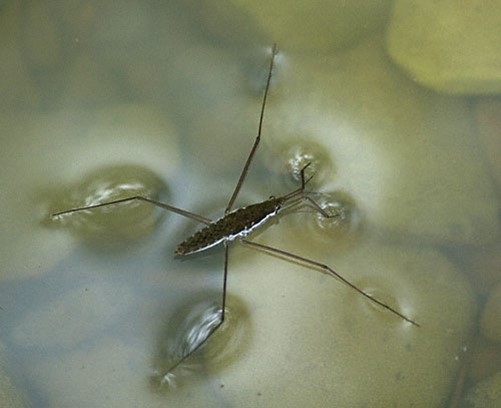
Credit: PD, via Wikimedia Commons
So-called water spiders aren’t spiders at all but insects specially evolved to walk on water.
There are 1,700 species of these water striders, which have existed on Earth for millions of years.
If you’ve ever wondered how they skate so effortlessly across a pond without falling in, the answer is surface tension—and their very specific adaptation to it.
Water molecules, as we’ve discussed on prior EarthDates, bond together tightly, especially where water meets air. This creates a membrane-like surface that the water skaters take advantage of.
Their long legs are useless on land. But they’re equipped with thousands of microscopic hairs that trap air in nanogrooves. The air repels water, keeping the surface tension intact though the insect is moving across it.
And move they do, at up to 100 body lengths a second—the equivalent of a human traveling at 400 miles an hour.
They use their incredible speed to catch prey that also live in this unique environment: other insects, small spiders, and, their favorite food, mosquito larvae.
This makes water striders a beneficial insect in controlling mosquito populations.
In ideal conditions, water skaters can live up to a year, hatching new eggs every two weeks. And when their ponds are drying up, they’re able to spawn a new generation with wings, to fly off to find another pond to skate on.
Background
Synopsis: Water striders “walk on water” by using one of its special properties: surface tension. Millions of years ago striders evolved microscopic leg hairs that capture air, effectively repelling water to keep its surface tension intact. This enables their trampoline-like movement along it on long legs that distribute their weight, suspending them over the water’s surface. But their legs are virtually useless on land, so these beneficial bugs spend their lives on the water’s surface, flying puddle to pond during drought.
- You have probably noticed tiny bugs that appear to make tiny dimples as they stand on the surface of lakes, streams, ponds and puddles.
- More than 1,700 species of modern pond skaters from the family Gerridae, commonly called gerrids, can be found skimming across water surfaces all around the world, preferring waters temperatures around 77 °F (25 °C).
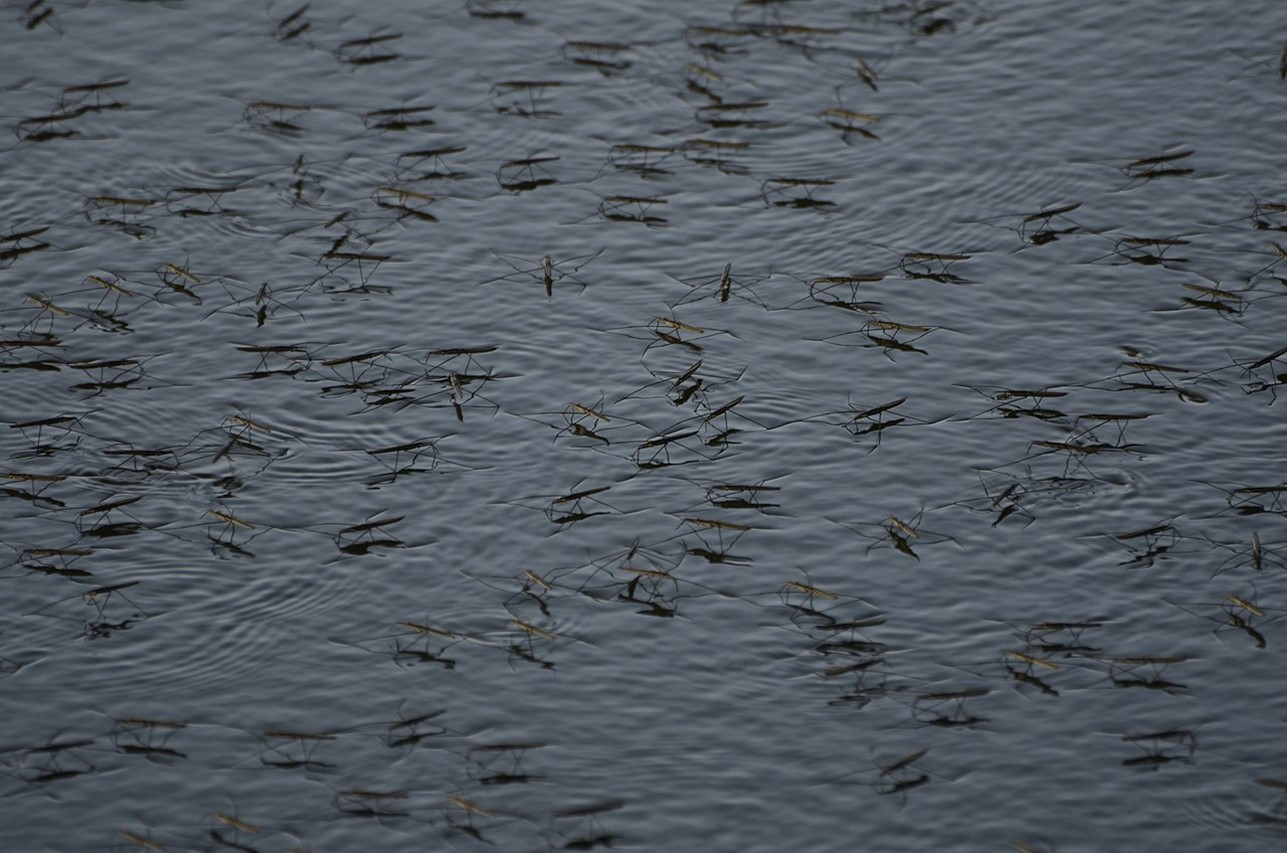
Gerrids gather on the surface of a pond in southern India.
Credit: PJeganathan, via Wikimedia Commons - About 90% of these species live on calm to slow-flowing fresh water, but about 10% live on brackish or salt water.
- While they may resemble spiders because of their long legs, with just three sets of legs they are true insects.
- They range in size from about 1/4 to 1 in (6–25 mm).
- More than 1,700 species of modern pond skaters from the family Gerridae, commonly called gerrids, can be found skimming across water surfaces all around the world, preferring waters temperatures around 77 °F (25 °C).
- Insects known as water striders, water bugs, pond skaters, water skippers or water skimmers have skated across Earth’s water bodies for more than 150 million years.
- Extinct water skating insects, Chresmoda, are found as 150-million-year-old fossils from the famous Late Jurassic Solnhofen fossil site in Germany. Some of these are as large as 7.5 in (19 cm) across, but most are about 1 in (2.5 cm) long with a 1 in (2.5 cm) leg span. This family of water striders flourished until their extinction during the Upper Cretaceous (94 million years ago).
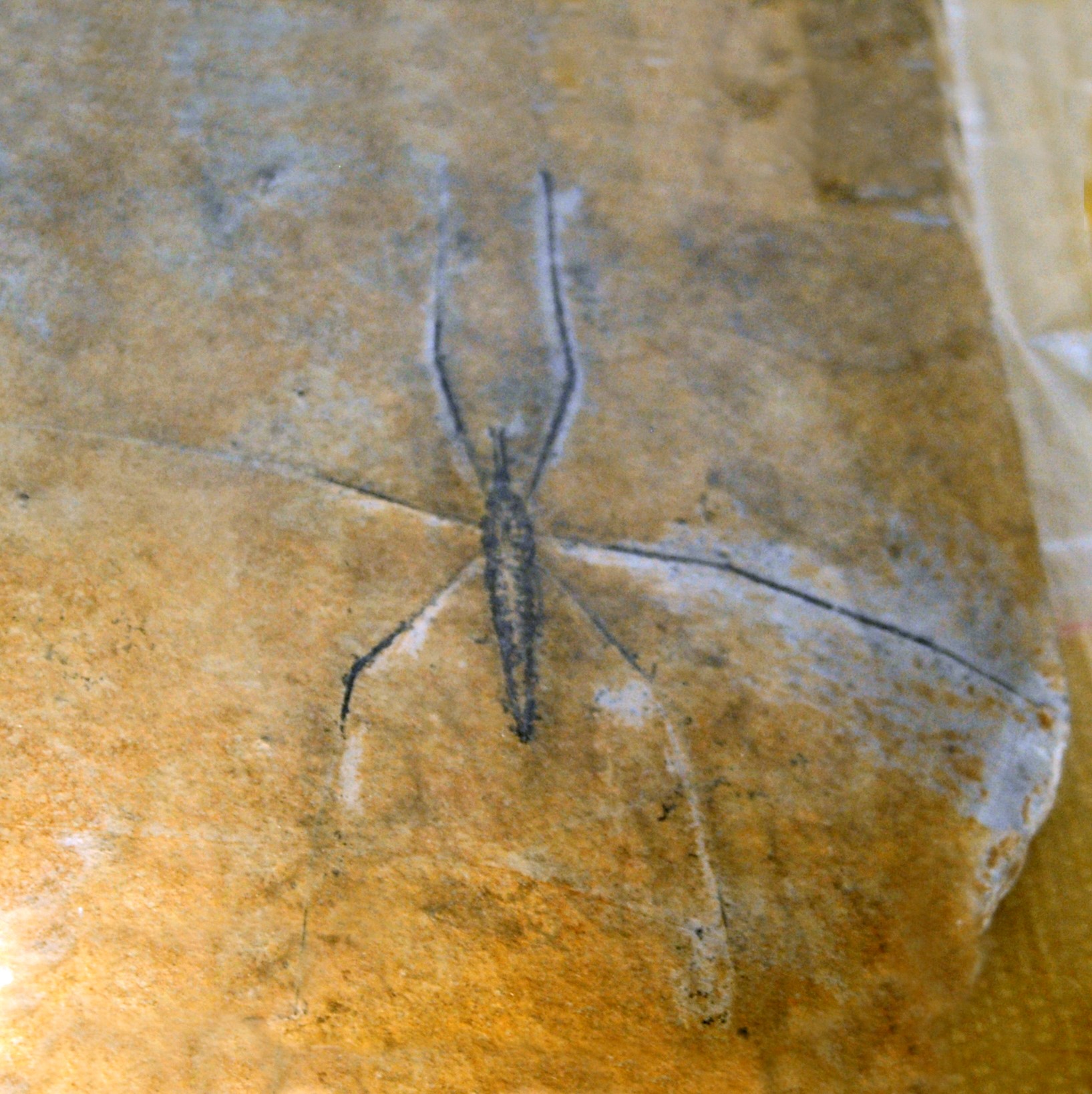
Fossil specimen of Chresmoda obscura from Jurassic rocks in Germany, on display at the Gallery of Paleontology and Comparative Anatomy in Paris.
Credit: Hectonichus, via Wikimedia Commons - The oldest cousin from the same family as modern water striders is Cretogerris found preserved in French amber dating to the Cretaceous Albian age (113–100 million years ago).
- Extinct water skating insects, Chresmoda, are found as 150-million-year-old fossils from the famous Late Jurassic Solnhofen fossil site in Germany. Some of these are as large as 7.5 in (19 cm) across, but most are about 1 in (2.5 cm) long with a 1 in (2.5 cm) leg span. This family of water striders flourished until their extinction during the Upper Cretaceous (94 million years ago).
- How do they walk on water? They use specially evolved water-repelling legs to exploit the same property of water that makes water droplets spherical—surface tension.
- Water has many special properties that we have talked about in past EarthDate episodes (ED-082 Water of Life, ED-141 Why is Ice Slippery? and ED-154 True Blue).
- The H2O molecule is a polar molecule, with an oxygen atom carrying a double negative charge at one of its ends and two positively charged hydrogen atoms at the other end—each molecule is a tiny electric dipole.
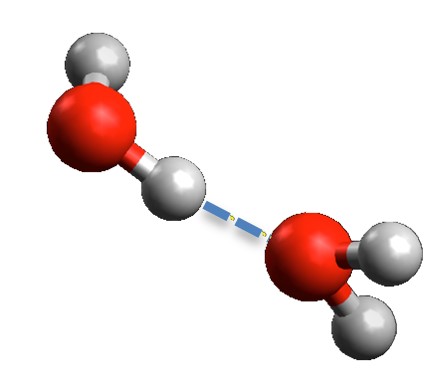
The red oxygen atom has a negative charge and attracts the positively charged hydrogen atom creating a hydrogen bond (dashed line).
Credit: Computer model image by Davide Donadio, UC Davis. - Water is called the “universal solvent” because polar H2O molecules attract all kinds of charged particles. Water can’t dissolve uncharged substances like oil.
- Water molecules are also strongly attracted to each other. Their negative ends bind with the positive ends of nearby water molecules through a special strong bond called a hydrogen bond, causing them to clump together.
- At an air–water interface, water molecules create an even stronger double hydrogen bond with their neighbors because they lack attraction to air molecules.
- This strong bonding creates a delicate elastic membrane-like effect that is known as surface tension. This is where water striders walk.
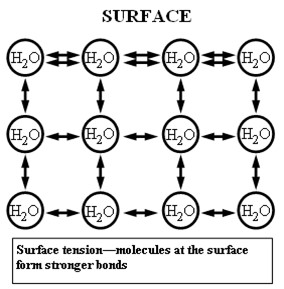
Water molecules attract each another strongly, but they are not attracted to uncharged air molecules. At an air–water interface, the outermost layer of molecules create extra strong bonds, increasing cohesion and producing surface tension.
Credit: USGS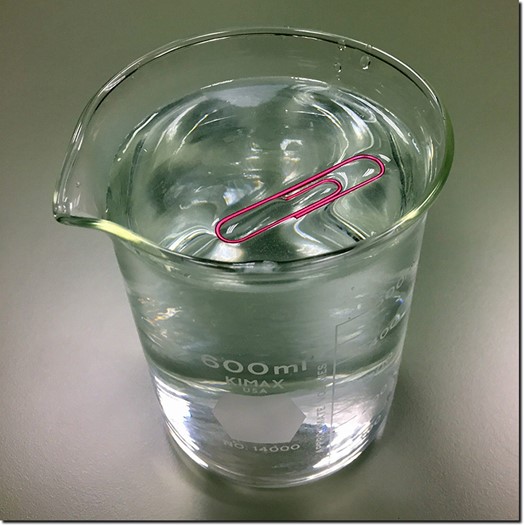
It seems to defy the laws of physics, but, if gently placed on a calm water surface, a metal paper clip will float because of surface tension. Water striders use the same principle to fill their ecological niche at the water’s surface.
Credit: USGS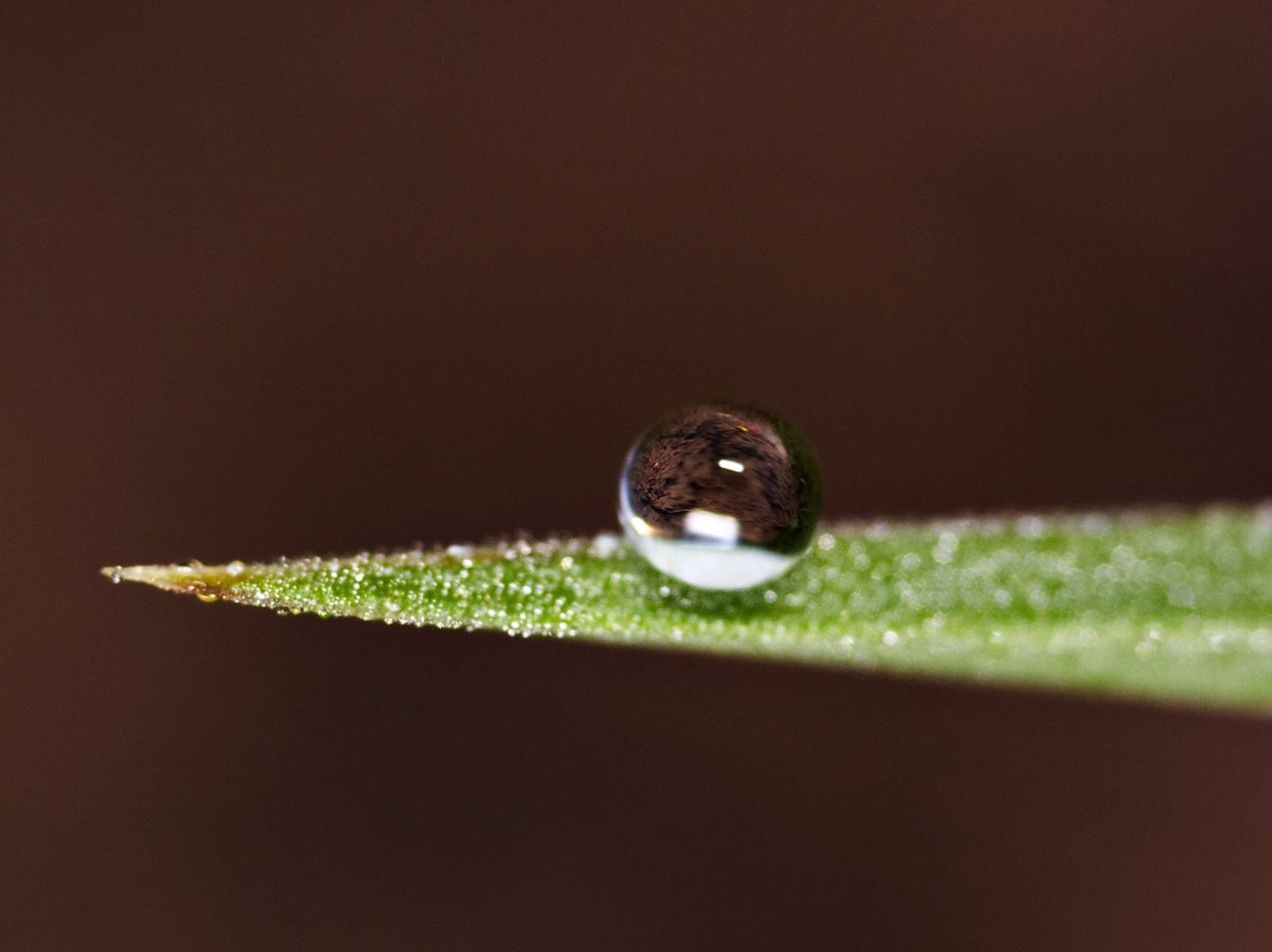
A tiny dew droplet, about 1 millimeter in diameter, rests on a leaf, illustrating the surface tension property of water.
Credit: Michael Apel, via Wikimedia Commons
- The anatomy of water strider legs holds the secret to their ability to stand upon and race across the delicate surface tension “membrane” at the water’s surface (watch a video here).
- Their slender flexible legs are widely spaced to distribute their weight across the water’s surface, keeping the body of the insect suspended above the water.
- Their legs are equipped with microscopic hydrophobic (water-repelling) hairs that attract air into nanogrooves, thus repelling water. This prevents their legs from breaking through the surface tension on the water’s surface. Their legs can support 15 times the weight of the strider without sinking.
- Their bodies are covered with thousands of tiny water-repelling hydrophobic hairs that also trap air, adding to their buoyancy if wetting occurs from rain or wave action.
- The short front pair of legs is used for grabbing and holding prey while eating, the long middle pair are used for paddling, and the long rear pair serves to “steer” and “brake” the insect’s movement.
- They move incredibly quickly and can paddle at more than 100 body lengths per second, the equivalent of a human moving at more than 400 mph (643 km/h) under their own power.
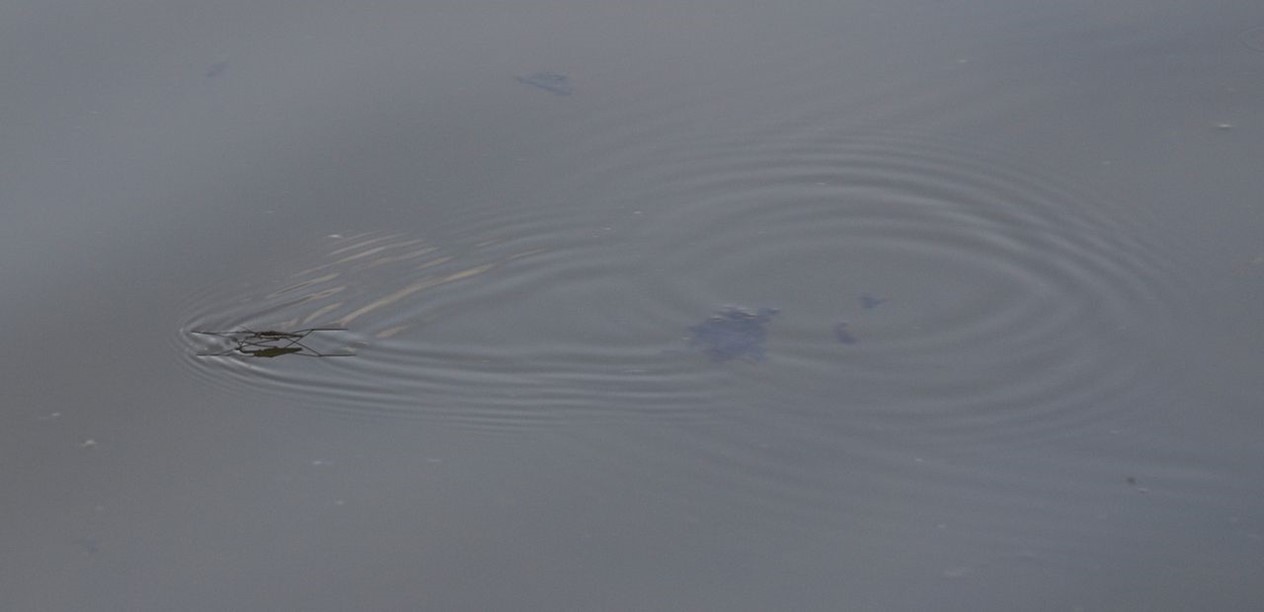
Water striders use their legs to propel and steer on the water.
Credit: DyPeMaP, via Wikimedia Commons - However, their special legs cannot support them on hard surfaces like land or in fluids that are nonpolar (with low surface tension), like oil.
- Water striders are beneficial insects that hunt at the water’s surface, using their amazing speed to capture prey they locate by sensing vibrations in the water.
- They consume live or dead insects, spiders, and even small tadpoles.
- They have a special fondness for mosquito larvae that they grab by the snorkel the larvae extend to the surface for breathing.
- Like other insects their mouthparts consist of a hollow piercing tube that they use like a straw to suck body fluids from their prey, but their mouthparts are too soft to penetrate the skin of larger animals like fish, mammals and humans.
- They are prey for birds, frogs and turtles, as well as some fish and other aquatic insects. Some fish appear not to like their taste.
- Water striders migrate to new water surfaces by flying, often appearing in a new puddle just minutes after it forms.
- Their wings develop to suit not only their habitat but also their situation. This is known as polymorphism.
- For example, if temperatures are rising and wet habitat might disappear, broods will be born with wings to help them escape their drying wetland. But if water is plentiful and they don’t need to migrate, a wingless brood will be born to optimize energy expenditure.
- This enables gerrids to outlast habitat change through generational change.
- In ideal conditions individuals can live up to a year.
- Their eggs hatch about every two weeks until a freeze occurs, killing adults, but eggs overwinter and hatch in the spring.
- Materials scientists are studying details of how the leg hairs of gerrids expel water at the nanoscale in hopes that they will be able to design superhydrophobic materials that would better repel water. Some might enable faster movement across water.

